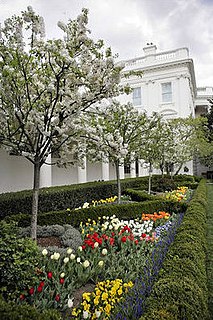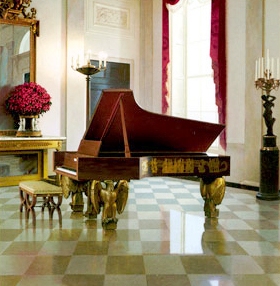
The White House is the official residence and workplace of the president of the United States. It is located at 1600 Pennsylvania Avenue NW in Washington, D.C. and has been the residence of every U.S. president since John Adams in 1800. The term "White House" is often used as a metonym for the president and his advisers.

The Oval Office is, since 1909, the working office space of the president of the United States, located in the West Wing of the White House, Washington, D.C.

The White House Rose Garden is a garden bordering the Oval Office and the West Wing of the White House in Washington, D.C., United States. The garden is approximately 125 feet long and 60 feet wide. It balances the Jacqueline Kennedy Garden on the east side of the White House Complex.

The White House Library is on the Ground Floor of the White House, the official home of the President of the United States. The room is approximately 27 by 23 feet and is in the northeast of the ground floor. The Library is used for teas and meetings hosted by the President and First Lady. During the 1950s reconstruction of the White House, old building lumber from the house was salvaged and re-made into wall paneling for this room. Several basement rooms in the White House are paneled with salvaged building materials from the pre-reconstructed White House.

The Vermeil Room is located on the ground floor of the White House, the official residence of the President of the United States. The room houses a collection of silver-gilt or vermeil tableware, a 1956 bequest to the White House by Margaret Thompson Biddle. Portraits of American First Ladies hang in the room.

The Diplomatic Reception Room is one of three oval rooms in the Executive Residence of the White House, the official home of the President of the United States. It is located on the ground floor and is used as an entrance from the South Lawn, and a reception room for foreign ambassadors to present their credentials, a ceremony formerly conducted in the Blue Room. The room is the point of entry to the White House for a visiting head of state following the State Arrival Ceremony on the South Lawn. The room has four doors, which lead to the Map Room, the Center Hall, the China Room, and a vestibule that leads to the South Lawn.

The Cross Hall is a broad hallway on the first floor in the White House, the official residence of the President of the United States. It runs east to west connecting the State Dining Room with the East Room. The room is used for receiving lines following a State Arrival Ceremony on the South Lawn, or a procession of the President and a visiting head of state and their spouses.

The Yellow Oval Room is an oval room located on the south side of the second floor in the White House, the official residence of the President of the United States. First used as a drawing room in the John Adams administration, it has been used as a library, office, and family parlor. Today the Yellow Oval Room is used for small receptions and for greeting heads of states immediately before a State Dinner.

The Treaty Room is located on the second floor of the White House, the official residence of the President of the United States. The room is a part of the first family's private apartments and is used as a study by the president.

The Jacqueline Kennedy Garden is located at the White House south of the East Colonnade. The garden balances the Rose Garden on the west side of the White House Complex.

The Committee for the Preservation of the White House is an advisory committee charged with the preservation of the White House, the official home and principal workplace of the President of the United States. The committee is largely made up of citizens appointed by the president for their experience with historic preservation, architecture, decorative arts, and for their scholarship in these areas.

The Cabinet Room is the meeting room for the cabinet secretaries and advisors serving the President of the United States. The body is defined as the United States Cabinet. The Cabinet Room is located in the West Wing of the White House, adjoining the Oval Office, and looks out upon the White House Rose Garden.

The Roosevelt Room is a meeting room in the West Wing of the White House, the home and main workplace of the President of the United States. Located in the center of the wing, near the Oval Office, it is named after two related U.S. presidents, Theodore Roosevelt and Franklin D. Roosevelt, who contributed to the wing's design.

The Entrance Hall is the primary and formal entrance to the White House, the official residence of the President of the United States. The room is rectilinear in shape and measures approximately 31 by 44 feet. Located on the State Floor, the room is entered from outdoors through the North Portico, which faces the North Lawn and Pennsylvania Avenue. The south side of the room opens to the Cross Hall through a screen of paired Roman Doric columns. The east wall opens to the Grand Staircase.

The Grand Staircase is the chief stairway connecting the State Floor and the Second Floor of the White House, the official home of the President of the United States. The stairway is primarily used for a ceremony called the Presidential Entrance March. The present Grand Staircase, the fourth staircase occupying the same general space, was completed in 1952 as a part of the Truman White House reconstruction. The Grand Staircase is entered on the State Floor from the Entrance Hall.

The North Lawn at the White House in Washington, DC, is bordered on the north by Pennsylvania Avenue with a wide view of the mansion, and is screened by dense plantings on the east from East Executive Drive and the Treasury Building, and on the west from West Executive Drive and the Old Executive Office Building. Because it is bordered by Pennsylvania Avenue, the White House's official street address, the North Lawn is sometimes described as the front lawn.

The West Sitting Hall is located on the second floor of the White House, home of the President of the United States. The room is entered from the second floor Center Hall on the east side of the room. The room features a large lunette window on the west wall looks out upon the West Colonnade, the West Wing, and the Old Executive Office Building. The room is used by first families as a less formal living room than the Yellow Oval Room.

The White House has had multiple vegetable gardens since its completion in 1800. Eleanor Roosevelt, Hillary Clinton and Michelle Obama all have had their own versions of vegetable gardens. Roosevelt planted the White House victory garden during World War II to promote the use of victory gardens by American citizens in a time of possible food scarcity. Hillary Clinton had a vegetable garden constructed on the roof of the White House. On March 20, 2009 Michelle Obama broke ground on the largest and most expansive vegetable garden to date on the White House lawn.

The Yaralla Estate, also known as the Dame Eadith Walker Estate and now home to the Dame Eadith Walker Hospital, is a heritage-listed hospital at The Drive, Concord West, City of Canada Bay in Sydney, New South Wales, Australia.

Macron's oak was the sessile oak tree that was given by the French president Emmanuel Macron to the United States in 2018.
































